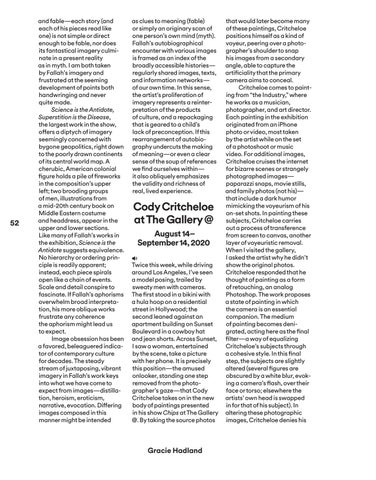52
and fable—each story (and each of his pieces read like one) is not simple or direct enough to be fable, nor does its fantastical imagery culminate in a present reality as in myth. I am both taken by Fallah’s imagery and frustrated at the seeming development of points both handwringing and never quite made. Science is the Antidote, Superstition is the Disease, the largest work in the show, offers a diptych of imagery seemingly concerned with bygone geopolitics, right down to the poorly drawn continents of its central world map. A cherubic, American colonial figure holds a pile of fireworks in the composition’s upper left; two brooding groups of men, illustrations from a mid-20th century book on Middle Eastern costume and headdress, appear in the upper and lower sections. Like many of Fallah’s works in the exhibition, Science is the Antidote suggests equivalence. No hierarchy or ordering principle is readily apparent; instead, each piece spirals open like a chain of events. Scale and detail conspire to fascinate. If Fallah’s aphorisms overwhelm broad interpretation, his more oblique works frustrate any coherence the aphorism might lead us to expect. Image obsession has been a favored, beleaguered indicator of contemporary culture for decades. The steady stream of juxtaposing, vibrant imagery in Fallah’s work keys into what we have come to expect from images—distillation, heroism, eroticism, narrative, evocation. Differing images composed in this manner might be intended
as clues to meaning (fable) or simply an originary scan of one person’s own mind (myth). Fallah’s autobiographical encounter with various images is framed as an index of the broadly accessible histories— regularly shared images, texts, and information networks— of our own time. In this sense, the artist’s proliferation of imagery represents a reinterpretation of the products of culture, and a repackaging that is geared to a child’s lack of preconception. If this rearrangement of autobio graphy undercuts the making of meaning—or even a clear sense of the soup of references we find ourselves within— it also obliquely emphasizes the validity and richness of real, lived experience.
Cody Critcheloe at The Gallery @ August 14– September 14, 2020 Twice this week, while driving around Los Angeles, I’ve seen a model posing, trailed by sweaty men with cameras. The first stood in a bikini with a hula hoop on a residential street in Hollywood; the second leaned against an apartment building on Sunset Boulevard in a cowboy hat and jean shorts. Across Sunset, I saw a woman, entertained by the scene, take a picture with her phone. It is precisely this position—the amused onlooker, standing one step removed from the photo grapher’s gaze—that Cody Critcheloe takes on in the new body of paintings presented in his show Chips at The Gallery @. By taking the source photos
Gracie Hadland
that would later become many of these paintings, Critcheloe positions himself as a kind of voyeur, peering over a photo grapher’s shoulder to snap his images from a secondary angle, able to capture the artificiality that the primary camera aims to conceal. Critcheloe comes to painting from “the Industry,” where he works as a musician, photographer, and art director. Each painting in the exhibition originated from an iPhone photo or video, most taken by the artist while on the set of a photoshoot or music video. For additional images, Critcheloe cruises the internet for bizarre scenes or strangely photographed images— paparazzi snaps, movie stills, and family photos (not his)— that include a dark humor mimicking the voyeurism of his on-set shots. In painting these subjects, Critcheloe carries out a process of transference from screen to canvas, another layer of voyeuristic removal. When I visited the gallery, I asked the artist why he didn’t show the original photos. Critcheloe responded that he thought of painting as a form of retouching, an analog Photoshop. The work proposes a state of painting in which the camera is an essential companion. The medium of painting becomes denigrated, acting here as the final filter—a way of equalizing Critcheloe’s subjects through a cohesive style. In this final step, the subjects are slightly altered (several figures are obscured by a white blur, evoking a camera’s flash, over their face or torso; elsewhere the artists’ own head is swapped in for that of his subject). In altering these photographic images, Critcheloe denies his
